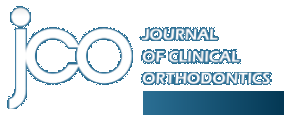Search Results For: 'case report'
1681.
BOOK REVIEWS
Volume 52 : Number 12 : Page 714 : Dec 2018
SANDRA TAI, BDS, MS 320 pages, 1,344 illustrations. $218. 2018. Quintessence Publishing Co., Inc., 4350 Chandler Drive, Hanover Park, IL 60133.(800) 621-0387; www.quintpub.com. As a former Director of...
1682.
BOOK REVIEWS
Dentofacial Esthetics: From Macro to Micro
Volume 55 : Number 6 : Page 342 : Jun 2021
DAVID M. SARVER, DMD, MS 512 pages, 2,500+ illustrations. $268. 2020.Quintessence Publishing Co., Inc. 411 N. Raddant Road, Batavia, IL 60510(800) 621-0387; www.quintbook.com. It is indeed my pleasure...
1683.
Product News in May 2022 Issue
Volume 56 : Number 5 : Page 313 : May 2022
PRODUCT NEWS is presented as a service to the reader and in no way implies endorsement by JCO.
1684.
Practical Invisalign Mechanics: Crowding
Volume 59 : Number 8 : Page 485 : Aug 2025
The second installment in Dr. Glaser’s series on managing common problems with Invisalign explains the biomechanical principles underlying the treatment of dental crowding and applies them to the case of a growing patient with significant crowding and a deep overbite.
1685.
The Universal Appliance Today, Part II
Volume 3 : Number 12 : Page 639 : Dec 1969
The Case This case is essentially a Class I type of malocclusion (Class I right side, slight Class II left side) of a 13-year-old girl. It presents a lack of space for the four canines and the mandibu...
1686.
Volume 5 : Number 8 : Page 421 : Aug 1971
I wish to emphasize at the start that the cases that will be presented are part of a symposium on borderline cases which indicates that there is an ambivalence in diagnosis and in treatment planning. ...
1687.
Volume 8 : Number 6 : Page 309 : Jun 1974
The term surgical-orthodontics has been used to describe surgical procedures in conjunction with orthodontic procedures and surgical procedures as a substitute for orthodontic procedures. What is real...
1688.
Volume 11 : Number 10 : Page 690 : Oct 1977
This is the first in a series of diagnostic case studies, each of which will illustrate a particular problem in orthodontic diagnosis. The presentation is divided into three sections. In Section I, we...
1689.
Volume 12 : Number 4 : Page 237 : Apr 1978
The Food and Drug Administration estimates that 30% of diagnostic medical and dental x-rays are unnecessary, at a cost of $2 billion a year. The materials alone are estimated to cost $150 million, or ...
1690.
Volume 25 : Number 11 : Page 0 : Nov 1991
Anterior bite planes have long been used for treatment of deep overbite and crossbite, Phase II occlusal correction of patients with TMJ dysfunction,1,2 elimination of bracket or cuspal interference t...
1691.
The Real Cost of Patient Financing
Volume 28 : Number 3 : Page 0 : Mar 1994
We've all heard the adage, "A bird in the hand is worth two in the bush." What about your accounts receivable? Is $90 in the hand really worth $100 "in the bush"? Is a discount of 10% appropriate when...
1692.
Overlay Mechanics with the Tip-Edge PLUS Bracket, Part 2: Class II and III Nonextraction Treatment
Volume 40 : Number 7 : Page 0 : Jul 2006
In conventional nonextraction treatment, using elastics for anchorage, orthodontists have found it challenging to maintain mandibular incisor positions in Class II cases or maxillary incisor control i...
1693.
THE EDITOR'S CORNER
The Complexities of Partial Treatment
Volume 42 : Number 10 : Page 549 : Oct 2008
The subject of partial treatment comes up frequently in both the orthodontic literature and day-to-day practice. While the main focus of our clinical activities is always on comprehensive treatment of...
1694.
Correction of Deep Bite in Adults Using the Invisalign System
Volume 42 : Number 12 : Page 0 : Dec 2008
Deep overbite is commonly treated by molar extrusion, incisor intrusion, or both. Careful diagnostic assessment is needed to determine the best treatment approach. Patients with structural deep bites ...
1695.
THE EDITOR'S CORNER
Volume 43 : Number 2 : Page 0 : Feb 2009
Some of the most challenging, and yet rewarding, cases that orthodontists face are those in which the only way to achieve a suitable outcome is through a combination of orthodontic treatment and ortho...
1696.
Class II Correction with the Invisalign System
Volume 44 : Number 1 : Page 0 : Jan 2010
The Invisalign system* has long been used to treat mild to moderate crowding, spacing, and tipped teeth.1-5 Recently, it has been used successfully in more complex cases, such as those involving extra...
1697.
THE EDITOR'S CORNER
Volume 48 : Number 12 : Page 741 : Dec 2014
It is hard to imagine an orthodontic topic that has generated more controversy or more heated debate than that of extractions. Years ago, when I was practicing general dentistry in a remote corner of ...
1698.
THE EDITOR'S CORNER
Volume 49 : Number 6 : Page 0 : Jun 2015
Over years of orthodontic practice, each of us develops a repertoire of case types we prefer to treat--in effect, a kind of personal sub-specialty in which we are particularly proficient. For example,...
1699.
How Long Should You Keep Your Business Records?
Volume 37 : Number 5 : Page 258 : May 2003
This article is reprinted by permission from The Blair/McGill Advisory, a monthly newsletter devoted to tax, financial planning, investment, and practice management matters exclusively for the dental ...
1700.
Volume 19 : Number 5 : Page 372 : May 1985
An effective letter system can be a good adjunct to building patient rapport and reinforcing a positive image of your practice. Written communications are effective because they are tangible. Letters ...
Showing 1681-1700 of 3241 results. Search completed in 0.091 seconds.

